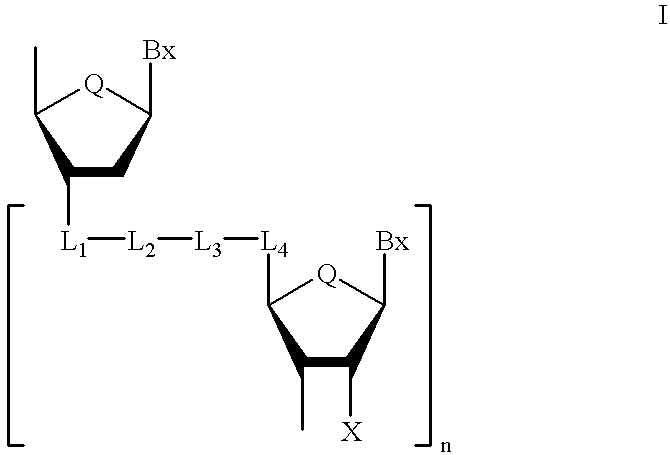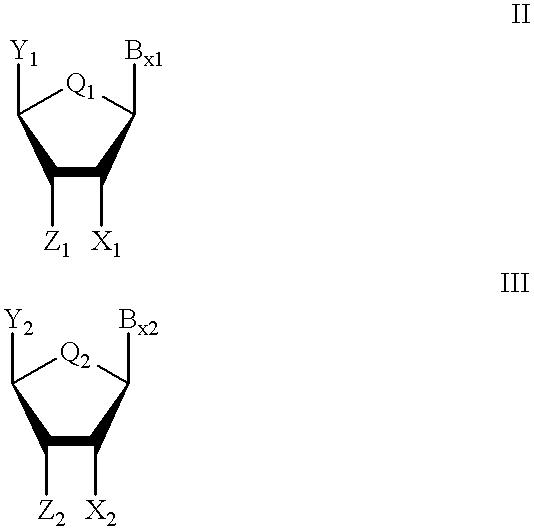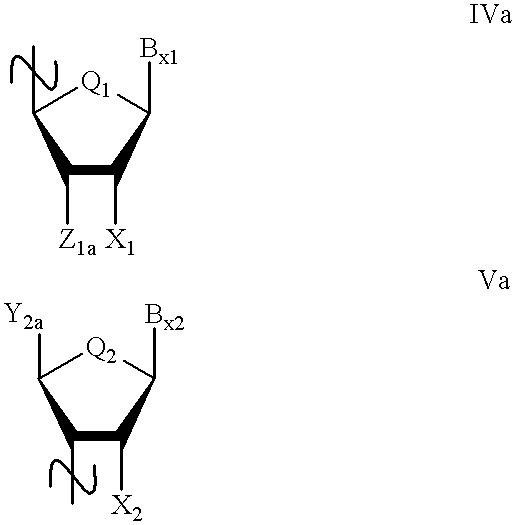Oligonucleoside linkages containing adjacent nitrogen atoms
a technology of nitrogen atoms and oligonucleotides, applied in the field of oligonucleotide analogs, can solve the problems of insufficient activity of many previously available antisense oligonucleotides for practical therapeutic, research or diagnostic purposes, and the inability to meet the needs of phosphate-modified oligonucleotides, and achieve sequence specific binding of oligonucleotide analogs, enhance cellular uptake o
- Summary
- Abstract
- Description
- Claims
- Application Information
AI Technical Summary
Benefits of technology
Problems solved by technology
Method used
Image
Examples
example 1
Synthesis of 5'-deoxy-5'-hydrazino nucleosides
(a) 5'-Deoxy-5'-hydrazinothysidine hydrochloride
To provide 5'-benzylcarbazyl-5'-deoxythymidine, 5'-O-tosylthymidine, [Nucleosides & Nucleotides 1990, 9, 89] (1.98 g, 5 mmol), benzylcarbazide (4.15 g, 25 mmol), activated molecular sieves (3A, 2 g), and anhydrous dimethylacetamide (100 ml) were stirred together with exclusion of moisture at 110.degree. C. (bath temperature) for 16 hours. The products were cooled and concentrated under reduced pressure (bath temperature <50.degree. C.). The residue was purified on a silica gel column (5.times.45 cm) with CH.sub.2 Cl.sub.2 / MeOH (9:1, v / v) as the solvent. The homogeneous fractions were pooled, evaporated to dryness and the foam recrystallized from EtOH to yield 0.7 g (36%) of 5'-benzylcarbazyl-5'-deoxythymidine; mp 201.degree. C.; .sup.1 H NMR (Me.sub.2 SO-d.sub.6) .delta. 1.79 (s, 3, CH.sub.3), 2.00-2.18 (m, 2, C.sub.2' CH.sub.2), 2.95 (t, 2, C.sub.5' CH.sub.2), 3.75 (m, 1, C.sub.4' H), 4.1...
example 2
Synthesis of 5'-O-trityl-1-[2,3-dideoxy-3-C-(formyl)-.beta.-D-erythro-pentofuranosyl]-thymine and -uracil
Method A
3'-C-Cyano-3'-deoxy-5'-O-tritylthymidine
The following preparation should to be performed under a hood and all precautions taken not to inhale any of reagent fumes. A suspension of 3'-deoxy-3'-iodo-5'-O-tritylthymidine (Verheyden, et al., J. Org. Chem. 1970, 35, 2868) (60 g, 0.1 mol), hexamethylditin (36 g, 22.7 ml, 0.11 mol), t-butylisocyanide (166 g, 225 ml, 2 mol), and AIBN (1.6 g, 10 mmol) in toluene (freshly distilled over Na / benzophenone, 2 lt) was thoroughly deoxygenated by bubbling argon through the reaction mixture for 30 min. and then heated at 80.degree. C. for 13 h. The reaction mixture was cooled at 60.degree. C. and AIBN (1.6 g, 10 mmol) was added and heating continued for 24 h. During this period addition of AIBN was repeated for 3 times in an identical manner. The reaction mixture was cooled to room temperature and transferred on the top of a prepacked sili...
example 3
Synthesis of methylenehydrazone linked (3'--CH.dbd.NH--N--CH.sub.2 --5'). methylenehydrazine linked (3'--CH.sub.2 --NH--NH--CH.sub.2 --5') and methylene(dimethylhydrazo) linked (3'--CH.sub.2 --N(CH.sub.3)--N(CH.sub.3)--CH.sub.2 --5') dinucleosides
3'-De(oxyphosphinico)-3'-[methylene(hydrazone)]-5'-O-tritylthymidylyl-(3'.fwdarw.5')-5'-deoxythymidine
A mixture of 3'-deoxy-3'-C-formyl-5'-O-tritylthymidine, 0.645 g, 1.30 mmol), 5'-deoxy-5'-hydrazinothymidine hydrochloride (0.397 g, 1.36 mmol) in dry CH.sub.2 Cl.sub.2 / MeOH / AcOH (20 ml / 10 ml / 0.5 ml) was stirred for 30 min at room temperature. The solvent was evaporated under vacuum and the hydrazone intermediate was analyzed by .sup.1 H NMR (DMSO-d.sub.6) .delta. 1.1 (br s, 2 NH), 8.3 (s, 1, C.dbd.N--NH), 7.5-7.74 (m, 17, T1 H, 2C.sub.6 H), 6.8 (1d, 1t, 1, HC.dbd.N, two isomers), 6.0-6.1 (2m, 2, H.sub.1'), 5.30 (br t, 1, OH), 3.8-4.2 (3m, 3, H.sub.3', 2 H.sub.4'), 3.0-3.3 (m, 5, 2H.sub.5',5", H.sub.3'), 2.0-2.4 (m, 4, 2H.sub.2', 2), 1.5 a...
PUM
| Property | Measurement | Unit |
|---|---|---|
| temperature | aaaaa | aaaaa |
| temperature | aaaaa | aaaaa |
| temperature | aaaaa | aaaaa |
Abstract
Description
Claims
Application Information
 Login to View More
Login to View More - R&D
- Intellectual Property
- Life Sciences
- Materials
- Tech Scout
- Unparalleled Data Quality
- Higher Quality Content
- 60% Fewer Hallucinations
Browse by: Latest US Patents, China's latest patents, Technical Efficacy Thesaurus, Application Domain, Technology Topic, Popular Technical Reports.
© 2025 PatSnap. All rights reserved.Legal|Privacy policy|Modern Slavery Act Transparency Statement|Sitemap|About US| Contact US: help@patsnap.com



